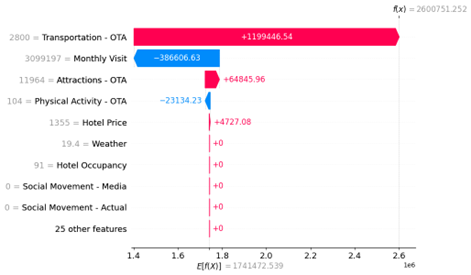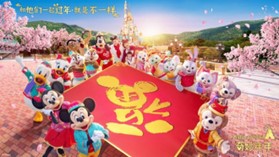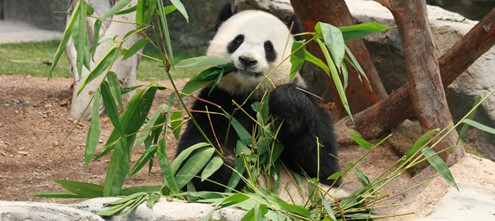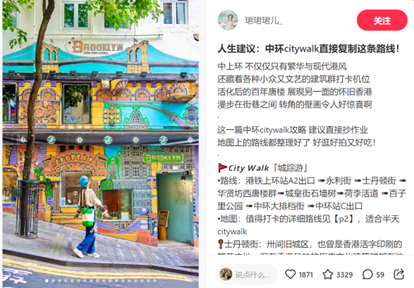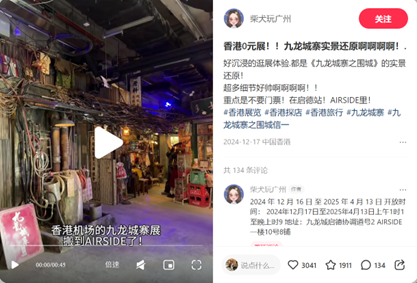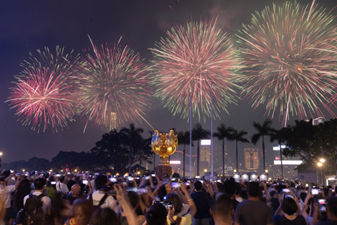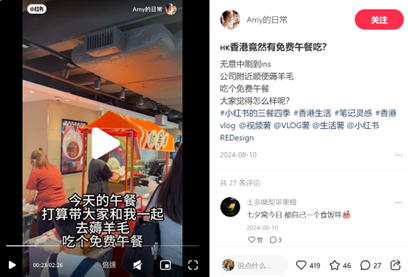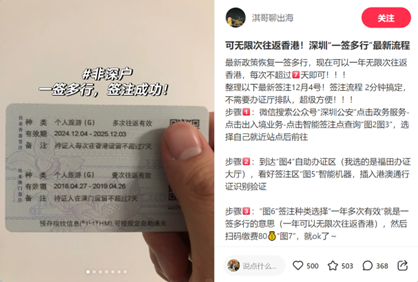According to the latest data from the Wisers Tourism Index, the increase in posts related to transportation and tourist attractions in Hong Kong may indicate a rise in visitor numbers in February 2025. Notably, discussions about “attractions” on mainland OTA media have had a significantly positive impact on these predictions.
In posts about “attractions,” advertisements related to travel tips for the Lunar New Year and winter holidays have seen a notable increase. Hong Kong Disneyland has become a focal point due to its family-friendly offerings during the winter holiday and Lunar New Year. As a globally renowned theme park, it not only introduces customized activities incorporating traditional festival elements during the Lunar New Year but also provides visitors with a rich entertainment experience, including spectacular parades, enchanting fireworks displays, and interactive sessions with beloved cartoon characters.
Overall analysis suggests that the seasonal travel demands during winter holidays and the Lunar New Year, combined with social media promotional effects, is expected to effectively drive growth in visitor numbers to Hong Kong in February 2025. What travel trends will emerge in Hong Kong this year? Let’s forecast this year’s key travel keywords across major platforms.
1. Pandas
The term “pandas” reached a buzz volume of 666,000 in 2024. In September 2024, two giant pandas named “An An” and “Ke Ke” were gifted to Hong Kong, alongside the birth of two local panda cubs, making giant pandas a new hot topic in Hong Kong tourism and attracting many visitors to Ocean Park. The Chief Executive introduced the concept of “panda tourism” as a distinctive tourism product for Hong Kong in the latest Policy Address. The government has launched various initiatives like “Pandas Everywhere in the Southern District” and outdoor carnivals such as “HELLO PANDAS,” while announcing that giant pandas will serve as “Hong Kong Tourism Ambassadors.” Ocean Park also revealed that the panda cubs might be open for public viewing after the Lunar New Year and announced plans to develop new IPs for six pandas, with creative new products set to be launched gradually. We recommend that the government further strengthen collaboration with Ocean Park, such as adding retail points for panda IP products at airports or opening exclusive panda shops in tourist areas to promote panda IP beyond Hong Kong.
2. District Tourism
The term “district tourism” reached a volume of 22,000 in 2024. The popularity of citywalk in 2024 indicates that travelers are shifting towards experiential and immersive travel styles, showing a preference for exploring unique local shops and urban streets. Last year, Xia Baolong, Director of the Hong Kong and Macao Affairs Office of State Council, advocated for the concept of “Tourism is everywhere in Hong Kong,” aiming to uncover tourism potential across Hong Kong’s eighteen districts. The government has launched projects promoting themed walking routes in Central, Sham Shui Po, and West Kowloon, as well as initiatives to promote Temple Street, attracting travelers to explore local communities around Yau Ma Tei and Jordan to experience authentic cultural characteristics.
According to Development Blueprint for Hong Kong’s Tourism Industry 2.0 (“Blueprint 2.0”), the government will continue enriching city walking routes and promote them from various angles, such as using movie maps to attract tourists to explore film locations across districts. The Tourism Board will also develop a food guide for all eighteen districts to promote local cuisine. We anticipate that deep exploration of district tourism will continue to trend among young travelers visiting Hong Kong in 2025. We suggest that the Tourism Board host photography competitions on platforms like Xiaohongshu (Little Red Book) to encourage travelers to discover the unique charms of different districts. The industry can also innovate experiential models by integrating distinctive dining, accommodation, and photo spots from various districts into travel itineraries.
3. Hong Kong Culture
The term “Hong Kong culture” reached a buzz volume of 100,000 in 2024. As a hub for cultural exchange between East and West, Hong Kong has produced numerous cultural icons over the years, such as Bruce Lee and trams. In recent years, authorities have organized multiple cultural events that not only attract visitors but also promote Hong Kong’s culture internationally. In 2024, the Leisure and Cultural Services Department held an exhibition,“A Path to Glory – Jin Yong’s Centennial Memorial, Sculpted by Ren Zhe”, celebrating Jin Yong’s centenary that recorded over 400,000 visitors; additionally, last year’s popular local film ” Twilight of the Warriors: Walled In ” sparked nostalgia with its 1:1 film set displayed at Hong Kong International Airport before moving to Kai Tak AIRSIDE. Kowloon Walled City Park is expected to launch indoor and outdoor film exhibitions by March this year, allowing visitors to experience historical street scenes and social landscapes of the Walled City. Another popular local film,”The Last Dance,” has also become a hot topic on mainland social media, with many fans expressing their desire to visit Hong Kong for uncut screenings of local films. We believe that this culture-based tourism model will continue to be one of Hong Kong’s tourism advantages.
4. Mega Events
The term “Mega Events” reached a buzz volume of 2.34 million in 2024. Over the years, Hong Kong has accumulated extensive experience hosting events of various types and scales. In 2024 alone, it hosted over 210 major events including the 2025 Hong Kong International Fur & Fashion Fair, Hong Kong Snooker All-Star Challenge, French May Arts Festival, and Hong Kong Wine & Dine Festival. The government has established a task force dedicated to coordinating mega events while announcing ” Development Blueprint for Hong Kong’s Tourism Industry 2.0,” which emphasizes mega events as an essential direction for tourism development. Key measures include partnering with “50 Best” organiser for three-year collaborations to host more award ceremonies related to food and wine; meanwhile, the Cultural and Creative Industries Development Agency aims to develop its flagship event “Hong Kong Fashion Week” into an annual highlight, positioning Hong Kong as an Asian fashion design center. It is evident that next year’s mega events will expand beyond traditional sports competitions and concerts into fashion, cultural arts, and culinary sectors.
However, following last year’s incident involving Messi’s absence from a Inter Miami CF friendly match and recent controversies surrounding attempts by Winman Advertising and Entertaining Group to bring FC Barcelona to Hong Kong for events, the government should consider adding escape clauses in contracts for government-funded events and penalties for non-fulfillment commitments to optimize event funding mechanisms. The government should also strengthen qualification checks on event organizers to prevent potential scams related to events that could damage Hong Kong’s image as an events capital.
5. Kai Tak Sports Park
The term “Kai Tak Sports Park” reached a buzz volume of 87,000 in 2024. Set to officially open in 2025, Kai Tak Sports Park is poised to become a new landmark for attracting cultural performances, competitions, and conferences. In the coming year, it will host concerts by British band Coldplay and Jay Chou’s world tour stop in Hong Kong; additionally, some events from the National Games of China will also take place there. Furthermore, Kai Tak Mall recently opened its doors. We expect Kai Tak will become a cultural and sports tourism center for Hong Kong, injecting new vitality into local tourism.
However, recent complications regarding Winman Advertising and Entertaining Group’s attempt to bring Barcelona FC for matches at Kai Tak highlight the need for more transparent and stringent approval processes regarding venue rentals.
6. Sports Tourism
The term “sports tourism” reached a buzz volume of 35,000 in 2024. Sports tourism is becoming increasingly popular across many regions as travelers engage with local sporting events through attendance or participation—bringing significant revenue opportunities for many places. For instance, horse racing is one of the few legal forms of gambling available in Asia; it has a long history in Hong Kong and remains popular among tourists. The Hong Kong Jockey Club welcomed approximately 93,000 tourists during the 2023/24 racing season—indicating substantial growth potential within sports tourism. Last year’s Policy Address even proposed developing horse racing tourism by exploring possibilities like introducing riding experiences or relaxing age restrictions on participants.
Hong Kong’s two gold and two bronze medals achieved at the Paris Olympics have significantly boosted local sports enthusiasm like never before. The Culture, Sports and Tourism Bureau stated in “Blueprint 2.0” that it will focus on attracting high-profile sports events while supporting invitations extended to star athletes—such as those expected at March’s “World Snooker Grand Prix 2025.” This marks Hong Kong’s first time hosting snooker ranking competitions in 35 years; top-ranked players are expected from around the world—indicating that attending or participating in sports activities will continue being appealing reasons for many travelers visiting Hong Kong this year.
7. Free
The term “free” reached a buzz volume of 4 million in 2024. Influenced by economic conditions since last year; mainland platforms have circulated travel guides promoting “consumption downgrading” or “freebie hunting,” aiming at maximizing free offers from businesses while minimizing travel costs. This trend not only reflects changing consumer attitudes but also suggests travelers are increasingly selecting more free attractions and activities; thus local tourism and retail sectors may need strategic adjustments—such as offering trial experiences or cost-effective activities—to attract visitors while stimulating consumption.
8. Multiple-entry
The term “multiple-entry” reached a buzz volume of 76,000 in 2024. In December 2024, Shenzhen resumed its “multiple-entry” Individual Visit Scheme (“Scheme”)—a move seen as part of central policies aimed at stimulating visitor inflow into Hong Kong which positively impacts local retailing, tourism, catering and service industries—indicating sustained benefits from this policy may continue bringing more tourist traffic into HK, while making short visits to Hong Kong a part of Shenzhen residents’ daily lives。 However,it is worth noting that this Scheme had previously triggered social side-effects like smuggling activities or product shortages which sparked discussions about HK’s capacity on handling influxes. As this Scheme drives people flow along with economic growth, the government should also monitor its social impacts closely.

